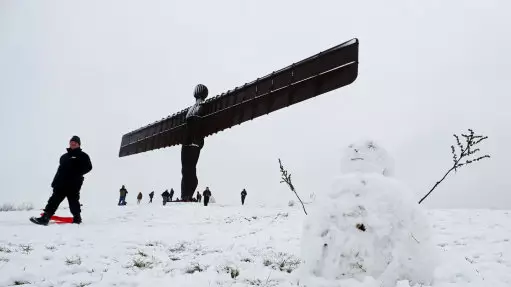
Britain's been surviving its fair share of wintry weather of late, with more wind and snow set to come swirling over the country for the whole of this week.
But this isn't just any weather, oh no. What we can look forward to is one of the rarer, cooler-named weather phenomenons to hit the UK: thundersnow.
As you might expect, thundersnow is basically the name for snow that falls during a thunderstorm. But the truth is that the phenomenon is a little more complicated and dangerous than that name might suggest.
Advert
CHECK OUT THUNDERSNOW IN ACTION IN THE US BELOW:
Thundersnow happens when thunderstorms form in wintry conditions. As the conditions that form a thunderstorm usually take place in summer, that means it's generally rarer.
The colder conditions cause the rain we usually associate with thunderstorms to fall in snow form instead, hence why it's called thundersnow. Quite logical, really.
Advert
Eleanor Bell, principal meteorologist of The Weather Channel, explains: "There needs to be an upward motion for the thunder to develop, warmer air trying to rise under colder air.
"It is less common than normal thunderstorms because it occurs in the colder months of the year when the air close to the ground is cold enough to produce snow."
For those of you who don't think a storm is really a storm unless it comes complete with thunder and lightning, rest assured that you won't be disappointed by thundersnow.
Advert
It comes with its own unique traits too - thundersnow lightning can be brighter than usual, while the thunder it produces is slightly quieter. Sounds pretty unusual.
"Interestingly, the snow contained within the thunderstorm acts to dampen the sound of the thunder," the UK's national weather service, the Met Office, said.
"While the thunder from a typical thunderstorm might be head many miles away, the thunder during a thundersnow event will only be heard if you are within two to three miles of the lightning.
"When thundersnow occurs at night the lightning seems brighter - this is because the lightning reflects off the snowflakes."
Advert
As cool as thundersnow sounds, it can still be pretty dangerous - thundersnow produces snow at rates of up to 5cm and 10cm an hour, making it very difficult to see.
That's why the Met Office have issued yellow National Severe Weather Warnings for Tuesday morning, urging people to be aware that their travel plans might be delayed.
So if you're in an area of the UK affected by thundersnow, you might find harder to get to where you need to tomorrow - but, hey, at least you'll get to witness the spectacle.
Featured Image Credit: PA